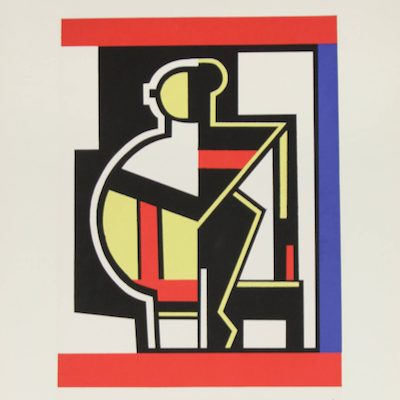
Details
Artist
Styles
Etching and aquatint in colours, on BFK Rives paper, with full margins. - This work is from the UNITÉ book, which began to be printed in 1963 and ended on October 15, 1965 in Paris. - I. 41.5 x 31.5 cm (16 3/8 x 12 3/8 in.) - S. 57 x 45.2 cm (22 1/2 x 17 3/4 in.) - Signed and numbered in pencil, from the edition of 130 pc + 30 in Roman numerals, published by Atelier Crommelynck, Paris // Le Corbusier’s Unité 9 (1963-1965) is a limited-edition etching and aquatint in colors, printed on BFK Rives paper. The composition presents a striking juxtaposition of abstracted human forms, with a reclining nude figure at the top, rendered in bold, curvilinear lines, and a stylized head at the bottom, filled with blocks of red, green, and yellow. The figure's simplified anatomy and expressive contour lines give the image a raw, primal energy, while the geometric patterns in the head suggest a more structured, intellectual element. The muted background colors of gray and green contrast with the vibrant hues in the figures, emphasizing the tension between organic and constructed forms—one of Le Corbusier’s recurring themes.
Unité 9, 1963-1965
form
Medium
Size
57 x 45.2 cm
- Inches
- Centimeters
Edition
Price
- USD
- EUR
- GBP
Details
Artist
Styles
Etching and aquatint in colours, on BFK Rives paper, with full margins. - This work is from the UNITÉ book, which began to be printed in 1963 and ended on October 15, 1965 in Paris. - I. 41.5 x 31.5 cm (16 3/8 x 12 3/8 in.) - S. 57 x 45.2 cm (22 1/2 x 17 3/4 in.) - Signed and numbered in pencil, from the edition of 130 pc + 30 in Roman numerals, published by Atelier Crommelynck, Paris // Le Corbusier’s Unité 9 (1963-1965) is a limited-edition etching and aquatint in colors, printed on BFK Rives paper. The composition presents a striking juxtaposition of abstracted human forms, with a reclining nude figure at the top, rendered in bold, curvilinear lines, and a stylized head at the bottom, filled with blocks of red, green, and yellow. The figure's simplified anatomy and expressive contour lines give the image a raw, primal energy, while the geometric patterns in the head suggest a more structured, intellectual element. The muted background colors of gray and green contrast with the vibrant hues in the figures, emphasizing the tension between organic and constructed forms—one of Le Corbusier’s recurring themes.
- Recently Added
- Price (low-high )
- Price (high-low )
- Year (low-high )
- Year (high-low )
What is Cubism?
Cubism is an art movement that aimed to depict multiple perspectives of objects or figures within a single picture. Artists Georges Braque and Pablo Picasso pioneered this style around 1907. The name Cubism emerged from their use of geometric shapes and outlines that often resembled cubes, breaking objects down into abstracted forms.



























